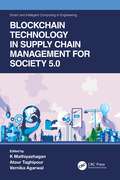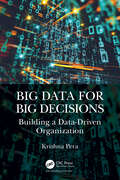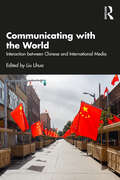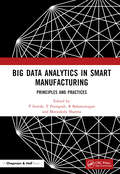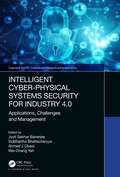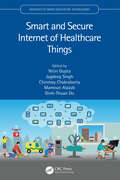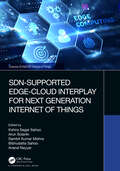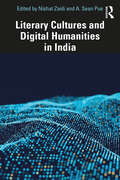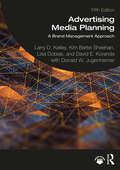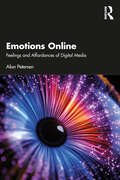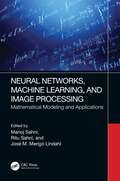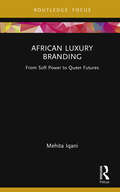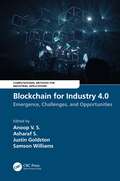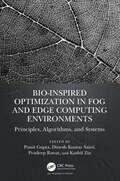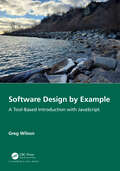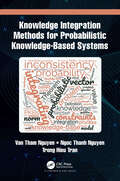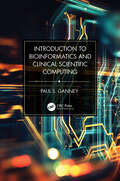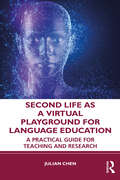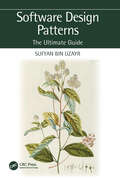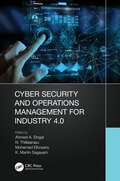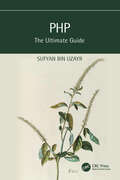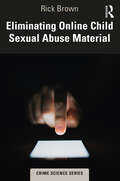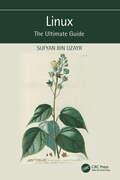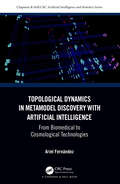- Table View
- List View
Blockchain Technology in Supply Chain Management for Society 5.0 (Smart and Intelligent Computing in Engineering)
by Vernika Agarwal K Mathiyazhagan Atour TaghipourSociety 5.0 is a human-centered community where integrated systems operate throughout society to secure comfort in all aspects of life, from energy and medical care, to education, work, and leisure. Blockchain technologies enable the streamlining of supply chain processes and information sharing among various industries. This book presents recent research on the adaptation and implementation of Blockchain technologies in supply chain management in Society 5.0. It discusses different applications of blockchain, its important role in connecting information technology and artificial intelligence with human lives, the challenges, and the future of supply chain management for societal improvements.
Big Data for Big Decisions: Building a Data-Driven Organization
by Krishna PeraBuilding a data-driven organization (DDO) is an enterprise-wide initiative that may consume and lock up resources for the long term. Understandably, any organization considering such an initiative would insist on a roadmap and business case to be prepared and evaluated prior to approval. This book presents a step-by-step methodology in order to create a roadmap and business case, and provides a narration of the constraints and experiences of managers who have attempted the setting up of DDOs. The emphasis is on the big decisions – the key decisions that influence 90% of business outcomes – starting from decision first and reengineering the data to the decisions process-chain and data governance, so as to ensure the right data are available at the right time, every time. Investing in artificial intelligence and data-driven decision making are now being considered a survival necessity for organizations to stay competitive. While every enterprise aspires to become 100% data-driven and every Chief Information Officer (CIO) has a budget, Gartner estimates over 80% of all analytics projects fail to deliver intended value. Most CIOs think a data-driven organization is a distant dream, especially while they are still struggling to explain the value from analytics. They know a few isolated successes, or a one-time leveraging of big data for decision making does not make an organization data-driven. As of now, there is no precise definition for data-driven organization or what qualifies an organization to call itself data-driven. Given the hype in the market for big data, analytics and AI, every CIO has a budget for analytics, but very little clarity on where to begin or how to choose and prioritize the analytics projects. Most end up investing in a visualization platform like Tableau or QlikView, which in essence is an improved version of their BI dashboard that the organization had invested into not too long ago. The most important stakeholders, the decision-makers, are rarely kept in the loop while choosing analytics projects. This book provides a fail-safe methodology for assured success in deriving intended value from investments into analytics. It is a practitioners’ handbook for creating a step-by-step transformational roadmap prioritizing the big data for the big decisions, the 10% of decisions that influence 90% of business outcomes, and delivering material improvements in the quality of decisions, as well as measurable value from analytics investments. The acid test for a data-driven organization is when all the big decisions, especially top-level strategic decisions, are taken based on data and not on the collective gut feeling of the decision makers in the organization.
Communicating with the World: Interaction between Chinese and International Media
by Liu LihuaThis book analyses the creation and dissemination of discourse in China while examining how its media and the people interact and communicate with the rest of the world. It explores the interplay between language, meanings, social practices, culture and politics in the processes of discourse generation. The book critically studies intercultural communication and Chinese discourse models at the national, institutional and individual levels and the different modes of interaction between China and the world. With the help of several case studies the book analyses reports from the People’s Daily, interpersonal meaning in promotional videos and advertisements in China, rhetoric in the editorials of China Daily and the representation by international media like The Associated Press and The New York Times to explore differences between Chinese and the Western media reporting the same event. It also looks at the complex models through which the Chinese people—both as individuals and as a collective—communicate with and gain an understanding of the rest of the world. Rich in empirical case studies, this book will be an essential read for scholars and researchers of Chinese Studies, communication studies, media and cultural studies, international relations and political communication.
Big Data Analytics in Smart Manufacturing: Principles and Practices
by T Poongodi Meenakshi Sharma P Suresh B BalamuruganThe significant objective of this edited book is to bridge the gap between smartmanufacturing and big data by exploring the challenges and limitations. Companiesemploy big data technology in the manufacturing field to acquire data about the products.Manufacturing companies could gain a deep business insight by tracking customer details,monitoring fuel consumption, detecting product defects, and supply chain management.Moreover, the convergence of smart manufacturing and big data analytics currently suffersdue to data privacy concern, short of qualified personnel, inadequate investment, long-termstorage management of high-quality data. The technological advancement makes the datastorage more accessible, cheaper and the convergence of these technologies seems to bemore promising in the recent era. This book identified the innovative challenges in theindustrial domains by integrating heterogeneous data sources such as structured data,semi-structures data, geo-spatial data, textual information, multimedia data, socialnetworking data, etc. It promotes data-driven business modelling processes by adoptingbig data technologies in the manufacturing industry. Big data analytics is emerging as apromising discipline in the manufacturing industry to build the rigid industrial dataplatforms. Moreover, big data facilitates process automation in the complete lifecycle ofproduct design and tracking. This book is an essential guide and reference since itsynthesizes interdisciplinary theoretical concepts, definitions, and models, involved insmart manufacturing domain. It also provides real-world scenarios and applications,making it accessible to a wider interdisciplinary audience. Features The readers will get an overview about the smart manufacturing system which enables optimized manufacturing processes and benefits the users by increasing overall profit. The researchers will get insight about how the big data technology leverages in finding new associations, factors and patterns through data stream observations in real time smart manufacturing systems. The industrialist can get an overview about the detection of defects in design, rapid response to market, innovative products to meet the customer requirement which can benefit their per capita income in better way. Discusses technical viewpoints, concepts, theories, and underlying assumptions that are used in smart manufacturing. Information delivered in a user-friendly manner for students, researchers, industrial experts, and business innovators, as well as for professionals and practitioners.
Intelligent Cyber-Physical Systems Security for Industry 4.0: Applications, Challenges and Management (Chapman & Hall/CRC Computational Intelligence and Its Applications)
by Siddhartha Bhattacharyya Jyoti Sekhar Banerjee Wei-Chang Yeh Ahmed J ObaidIntelligent Cyber-Physical Systems Security for Industry 4.0: Applications, Challenges and Management presents new cyber-physical security findings for Industry 4.0 using emerging technologies like artificial intelligence (with machine/deep learning), data mining, applied mathematics. All these are the essential components for processing data, recognizing patterns, modeling new techniques, and improving the advantages of data science. Features • Presents an integrated approach with Cyber-Physical Systems, CPS security, and Industry 4.0 in one place • Exposes the necessity of security initiatives, standards, security policies, and procedures in the context of industry 4.0 • Suggests solutions for enhancing the protection of 5G and the Internet of Things (IoT) security • Promotes how optimization or intelligent techniques envisage the role of artificial intelligence-machine/deep learning (AI-ML/DL) in cyberphysical systems security for industry 4.0 This book is primarily aimed at graduates, researchers and professionals working in the field of security. Executives concerned with security management, knowledge dissemination, information, and policy development for data and network security in different educational, government, and non-government organizations will also find this book useful.
Smart and Secure Internet of Healthcare Things (Advances in Smart Healthcare Technologies)
by Nitin Gupta Jagdeep Singh Mamoun Alazab Chinmay Chakraborty Dinh-Thuan DoInternet of Healthcare Things (IoHT) is an Internet of Things (IoT)-based solution that includes a network architecture which allows the connection between a patient and healthcare facilities. This book covers various research issues of smart and secure IoHT, aimed at providing solutions for remote healthcare monitoring using pertinent techniques. Applications of machine learning techniques and data analytics in IoHT, along with the latest communication and networking technologies and cloud computing, are also discussed. Features: Provides a detailed introduction to IoHT and its applications Reviews underlying sensor and hardware technologies Includes recent advances in the IoHT, such as remote healthcare monitoring and wearable devices Explores applications of data analytics/data mining in IoHT, including data management and data governance Focuses on regulatory and compliance issues in IoHT This book is intended for graduate students and researchers in Bioinformatics, Biomedical Engineering, Big Data and Analytics, Data Mining, and Information Management, IoT and Computer and Electrical Engineering.
SDN-Supported Edge-Cloud Interplay for Next Generation Internet of Things (Chapman & Hall/CRC Internet of Things)
by Anand Nayyar Sambit Kumar Mishra Arun Solanki Kshira Sagar Sahoo Bibhudatta SahooSDN-Supported Edge-Cloud Interplay for Next Generation Internet of Things is an invaluable resource coveringa wide range of research directions in the field of edge-cloud computing, SDN, and IoT. The integration of SDN in edge-cloud interplay is a promising framework for enhancing the QoS for complex IoT-driven applications. The interplay between cloud and edge solves some of the major challenges that arise in traditional IoT architecture. This book is a starting point for those involved in this research domain and explores a range of significant issues including network congestion, traffic management, latency, QoS, scalability, security, and controller placement problems. Features: The book covers emerging trends, issues and solutions in the direction of Edge-cloud interplay. It highlights the research advances in on SDN, edge, and IoT architecture for smart cities, and software-defined internet of vehicles. It includes detailed discussion has made of performance evaluations of SDN controllers, scalable software-defined edge computing, and AI for edge computing. Applications areas include machine learning and deep learning in SDN-supported edge-cloud systems. Different use cases covered include smart health care, smart city, internet of drones, etc. This book is designed for scientific communities including graduate students, academicians, and industry professionals who are interested in exploring technologies related to the internet of things such as cloud, SDN, edge, internet of drones, etc.
Literary Cultures and Digital Humanities in India
by Nishat Zaidi A. Sean PueThis book explores the use of digital humanities (DH) to understand, interpret, and annotate the poetics of Indian literary and cultural texts, which circulate in digital forms — in manuscripts — and as oral or musical performance. Drawing on the linguistic, cultural, historical, social, and geographic diversity of Indian texts and contexts, it foregrounds the use of digital technologies — including minimal computing, novel digital humanities research and teaching methodologies, critical archive generation and maintenance — for explicating poetics of Indian literatures and generating scholarly digital resources which will facilitate comparative readings. With contributions from DH scholars and practitioners from across India, the United States, the United Kingdom, and more, this book will be a key intervention for scholars and researchers of literature and literary theory, DH, media studies, and South Asian Studies.
Advertising Media Planning: A Brand Management Approach
by Donald W. Jugenheimer Larry D. Kelley Kim Bartel Sheehan Lisa Dobias David E. KorandaAdvertising Media Planning blends the latest methods for digital communication and an understanding of the global landscape with the best practices of the functional areas of media planning. Taking a unique brand communication approach from an agency perspective, the textbook is organized into four key parts, walking the student through the foundations of brand communication, communication planning, the different media channels available, and the process of preparing, presenting, and evaluating a media plan. This 5th edition has been fully updated to include: • An emphasis throughout on digital and global media planning • New chapters on the role of brand communication, media planning and data analytics, paid media, mobile media, influencer marketing, and B2B media • New mini-case studies and innovation-focused call-out boxes throughout, showcasing media examples from Europe, the United States, and Asia • Discussion questions to foster engagement and understanding A highly regarded new edition, this practical and integrated textbook should be core reading for advanced undergraduate and postgraduate students studying Media Planning, Advertising Management, Integrated Marketing Communication, and Brand Management. Instructor resources include: PowerPoint slides, a test bank, and an instructor manual.
Emotions Online: Feelings and Affordances of Digital Media
by Alan PetersenDigital media have become deeply immersed in our lives, heightening both hopes and fears of their affordances. While the internet, mobile phones, and social media offer their users many options, they also engender concerns about their manipulations and intrusions. Emotions Online explores the visions that shape responses to media and the emotional regimes that govern people’s engagements with them. This book critically examines evidence on the role of digital media in emotional life. Offering a sociological perspective and using ideas from science and technology studies and media studies, it explores: • The dimensions and operations of the online emotional economy• Growing concerns about online harms and abuse, especially to children• ‘Deepfakes’ and other forms of image-based abuse• The role of hope in shaping online behaviours• ‘Digital well-being’ and its market• COVID-19’s impacts on perceptions of digital media and Big Tech• Growing challenges to centralised control of the internet, and the implications for future emotional life The book breaks new ground in the sociological study of digital media and the emotions. It reveals the dynamics of online emotional regimes showing how deceptive designs and algorithm-driven technologies serve to attract and engage users. As it argues, digital media rely on the emotional labours of many people, including social media inf luencers and content moderators who make the internet seem smart. The book provides an invaluable overview of the evidence and debates on the role of digital media in emotional life and guidance for future research, policy, and action.
Neural Networks, Machine Learning, and Image Processing: Mathematical Modeling and Applications
by Manoj Sahni Ritu Sahni Jose M. MerigoSECTION I Mathematical Modeling and Neural Network’ Mathematical Essence Chapter 1 Mathematical Modeling on Thermoregulation in Sarcopenia1.1. Introduction 1.2. Discretization 1.3. Modeling and Simulation of Basal Metabolic Rate and Skin Layers Thickness 1.4. Mathematical Model and Boundary Conditions 1.5. Solution of the Model 1.6. Numerical Results and discussion 1.7. Conclusion References Chapter 2 Multi-objective University Course Scheduling for Un
African Luxury Branding: From Soft Power to Queer Futures (Routledge Critical Advertising Studies)
by Mehita IqaniBringing together critical race, queer and decolonial analytical approaches, visual analysis, and multimodal discourse analysis, this book explores the discursive strategies deployed by African luxury brands in an age of cross-platform, intertextual branding. Building on literature examining the aesthetics and politics of African luxury, this book demonstrates how leading African luxury brands create visual material speaking to complex sensibilities of culture, nature, and future. Iqani shows how powerful brand narratives and strategies reveal ethical and ideological messages that function to re-position Africa in an increasingly congested global marketplace of ideas. In acknowledging that there is a strong political validity to recognizing the importance of African brands staking their claim in luxury, this book also problematizes the role these brands play in the promotion of luxury discourses, advancing the project of capitalism and their contribution to broader patterns of inequality. Shedding new light not only on luxury branding strategies but also on the idea of a luxurious global “Africanicity” and on the complex cultural politics of South Africa, African Luxury Branding will be of interest to advanced students and researchers in disciplines, including Critical Advertising Studies, African Studies, Media and Communications.
Blockchain for Industry 4.0: Blockchain for Industry 4.0: Emergence, Challenges, and Opportunities (Computational Methods for Industrial Applications)
by Anoop V. S.This reference text provides the theoretical foundations, the emergence, and the application areas of Blockchain in an easy-to-understand manner that would be highly helpful for the researchers, academicians, and industry professionals to understand the disruptive potentials of Blockchain. It explains Blockchain concepts related to Industry 4.0, Smart Healthcare, and the Internet of Things (IoT) and explores Smart Contracts and Consensus algorithms. This book will serve as an ideal reference text for graduate students and academic researchers in electrical engineering, electronics and communication engineering, computer engineering, and information technology. This book • Discusses applications of blockchain technology in diverse sectors such as industry 4.0, education, finance, and supply chain. • Provides theoretical concepts, applications, and research advancements in the field of blockchain. • Covers industry 4.0 digitization platform and blockchain for data management in industry 4.0 in a comprehensive manner. • Emphasizes analysis and design of consensus algorithms, fault tolerance, and strategy to choose the correct consensus algorithm.• Introduces security issues in the industrial internet of things, internet of things, blockchain integration, and blockchain-based applications. The text presents in-depth coverage of theoretical concepts, applications and advances in the field of blockchain technology. This book will be an ideal reference for graduate students and academic researchers in diverse engineering fields such as electrical, electronics and communication, computer, and information technology.
Bio-Inspired Optimization in Fog and Edge Computing Environments: Principles, Algorithms, and Systems
by Punit Gupta Dinesh Kumar Saini Pradeep Singh Rawat Kashif ZiaA new era of complexity science is emerging, in which nature- and bio-inspired principles are being applied to provide solutions. At the same time, the complexity of systems is increasing due to such models like the Internet of Things (IoT) and fog computing. Will complexity science, applying the principles of nature, be able to tackle the challenges posed by highly complex networked systems? Bio-Inspired Optimization in Fog and Edge Computing: Principles, Algorithms, and Systems is an attempt to answer this question. It presents innovative, bio-inspired solutions for fog and edge computing and highlights the role of machine learning and informatics. Nature- or biological-inspired techniques are successful tools to understand and analyze a collective behavior. As this book demonstrates, algorithms, and mechanisms of self-organization of complex natural systems have been used to solve optimization problems, particularly in complex systems that are adaptive, ever-evolving, and distributed in nature. The chapters look at ways of enhancingto enhance the performance of fog networks in real-world applications using nature-based optimization techniques. They discuss challenges and provide solutions to the concerns of security, privacy, and power consumption in cloud data center nodes and fog computing networks. The book also examines how: The existing fog and edge architecture is used to provide solutions to future challenges. A geographical information system (GIS) can be used with fog computing to help users in an urban region access prime healthcare. An optimization framework helps in cloud resource management. Fog computing can improve the quality, quantity, long-term viability, and cost-effectiveness in agricultural production. Virtualization can support fog computing, increase resources to be allocated, and be applied to different network layers. The combination of fog computing and IoT or cloud computing can help healthcare workers predict and analyze diseases in patients.
Software Design by Example: A Tool-Based Introduction with JavaScript
by Greg WilsonThe best way to learn design in any field is to study examples, and some of the best examples of software design come from the tools programmers use in their own work. Software Design by Example: A Tool-Based Introduction with JavaScript therefore builds small versions of the things programmers use in order to demystify them and give some insights into how experienced programmers think. From a file backup system and a testing framework to a regular expression matcher, a browser layout engine, and a very small compiler, we explore common design patterns, show how making code easier to test also makes it easier to re-use, and help readers understand how debuggers, profilers, package managers, and version control systems work so that they can use them more effectively. This material can be used for self-paced study, in an undergraduate course on software design, or as the core of an intensive weeklong workshop for working programmers. Each chapter has a set of exercises ranging in size and difficulty from half a dozen lines to a full day's work. Readers should be familiar with the basics of modern JavaScript, but the more advanced features of the language are explained and illustrated as they are introduced. All the written material in this project can be freely reused under the terms of the Creative Commons - Attribution license, while all of the software is made available under the terms of the Hippocratic License. All proceeds from sale of this book will go to support the Red Door Family Shelter in Toronto. Features Teaches software design by showing programmers how to build the tools they use every day Each chapter includes exercises to help readers check and deepen their understanding All the example code can be downloaded, re-used, and modified under an open license
Knowledge Integration Methods for Probabilistic Knowledge-based Systems
by Ngoc Thanh Nguyen Van Tham Nguyen Trong Hieu TranKnowledge-based systems and solving knowledge integrating problems have seen a great surge of research activity in recent years. Knowledge Integration Methods provides a wide snapshot of building knowledge-based systems, inconsistency measures, methods for handling consistency, and methods for integrating knowledge bases. The book also provides the mathematical background to solving problems of restoring consistency and integrating probabilistic knowledge bases in the integrating process. The research results presented in the book can be applied in decision support systems, semantic web systems, multimedia information retrieval systems, medical imaging systems, cooperative information systems, and more. This text will be useful for computer science graduates and PhD students, in addition to researchers and readers working on knowledge management and ontology interpretation.
Introduction to Bioinformatics and Clinical Scientific Computing
by Paul S. GanneyThis textbook provides an introduction to computer science theory, informatics best practice, and the standards and legislation that apply to computing in a healthcare environment. It delivers an accessible discussion of databases (construction, interrogation and maintenance); networking (design and low-level application); programming (best practice rather than the specifics of any one language – design, maintenance, safety). It can be used to accompany the NHS Modernising Scientific Careers syllabus. It is also targeted towards those creating software rather than those using it, particularly computer scientists working in healthcare, specifically those in or close to the Physical Sciences, including radiotherapy, nuclear medicine, and equipment management and those working with genomics and health informatics.
Second Life as a Virtual Playground for Language Education: A Practical Guide for Teaching and Research
by Julian ChenThis insightful book offers language teachers and teachers in training the opportunity to delve into 3D virtual worlds and see the benefits they provide for effective language teaching. Based on a decade of experience teaching and researching in Second Life (SL), Chen demystifies the dos and don’ts of SL teaching and research, whilst vividly walking readers through each step of the journey. Written in an accessible, jargon-free, and personalised tone, the book is divided into three parts. Part I builds the foundation in SL research, task-based language teaching (TBLT), and understanding fundamental skills for SL teaching. Part II showcases the author’s SL teaching blog that generously unveils their task-based, SL-enabled lessons, participant observations, critical reflections, and lessons learned from each SL session. Part III is complete with the highlights of the author’s SL research and hands-on resources and tips for readers. Each chapter also features a "Checkpoint" section to gauge reader understanding of chapter content, followed by a "Your Task" section to promote learning by doing in SL. Teachers and curriculum designers will find the well-detailed and guided lesson planning useful when starting their first SL class. Graduate students and novice researchers will also find the systematically recorded data collection helpful for their SL research.
Software Design Patterns: The Ultimate Guide
by Sufyan bin UzayrSoftware Design Patterns are reusable solutions to software development difficulties. However, a Software Design Pattern is not code; rather, it is a guide or paradigm that helps software engineers to construct products that follow best practices. A Design Pattern is more of a template to tackle the topic at hand than a library or framework, which can be added and utilized right away. Object-oriented programming (OOP) is supported by Design Patterns, which are based on the ideas of objects (instances of a class; data with unique attributes) and classes (user-defined types of data). Design Patterns are blueprints for resolving typical software engineering issues. They provide reproducible solutions to some of the most prevalent difficulties you’ll encounter. That said, Design Patterns aren’t a complete solution, nor are they code, classes, or libraries that you may use in your project. They are a type of problem-solving solution. Each job will be approached in a slightly different way. Why Should You Learn Software Design Patterns? As a programmer, you can use Software Design Patterns to help you build more reliable structures. Design Patterns give you the skills to create smart and interactive applications or software with simple and easy problem-solving methods; they also allow you to create the greatest user-friendly apps and change them easily to meet the latest requirements. Design Patterns are interesting to deal with since such knowledge enables flexible coding patterns and structural techniques, reusable codes, loosely written codes, classes, patterns, and so on. This Book Contains: • A step-by-step approach to problem solving and skill development • A quick run-through of the basic concepts, in the form of a "Crash Course" • Advanced, hands-on core concepts, with a focus on real-world problems • Industry level coding paradigm with practice-oriented explanations • Special emphasis on writing clean and optimized code, with additional chapters focused on coding methodology
Cyber Security and Operations Management for Industry 4.0
by Ahmed A ElngarThis book seamlessly connects the topics of Industry 4.0 and cyber security. It discusses the risks and solutions of using cyber security techniques for Industry 4.0.Cyber Security and Operations Management for Industry 4.0 covers the cyber security risks involved in the integration of Industry 4.0 into businesses and highlights the issues and solutions. The book offers the latest theoretical and practical research in the management of cyber security issues common in Industry 4.0 and also discusses the ethical and legal perspectives of incorporating cyber security techniques and applications into the day-to-day functions of an organization. Industrial management topics related to smart factories, operations research, and value chains are also discussed.This book is ideal for industry professionals, researchers, and those in academia who are interested in learning more about how cyber security and Industry 4.0 are related and can work together.
PHP: The Ultimate Guide
by Sufyan bin UzayrThere is no shortage of websites that use the PHP programming language in some or other capacity. PHP (Hypertext Preprocessor) is a server-side scripting language that allows you to create dynamically-generated web pages. Rasmus Lerdorf created PHP in 1994. PHP works in the backend of a website because it is a server-side technology. This is the part of a website that no one sees. This means that PHP is frequently used to run server-side programs such as data collection and processing and database management. The fact that PHP is a simple language is one of the key reasons why learning it is a wise investment. PHP was created with the goal of speeding up web development; therefore, it features a basic syntax that is ideal for beginners. Furthermore, because PHP is a dynamically typed language, there are less restrictions to follow while creating features. The PHP programming language offers a wide range of applications and features, such as authentication, payments, user administration, and other "dynamic" aspects of a website. Efficiency, syntax compatibility, platform independence, error detection, and encryption are just a few of the interesting properties of PHP. Why Should You Learn PHP? PHP developers work with the PHP programming language to create websites, applications, and programs. As a PHP developer, you’ll usually be working in IT companies (all over the world), but there are also a lot of opportunities in design and business. A PHP developer, like any other programming/scripting language developer, should be able to work with many languages and ideally have some knowledge of database, web design, or some page formatting language. This Book Offers: • A step-by-step approach to problem solving and skill development • A quick run-through of the basic concepts, in the form of a "Crash Course" • Advanced, hands-on core concepts, with a focus on real-world problems • Industry-level coding paradigms and a practice-oriented explanatory approach • Special emphasis on writing clean and optimized code, with additional chapters focused on coding methodology
Eliminating Online Child Sexual Abuse Material (Crime Science Series)
by Rick BrownThis book uses a crime science approach to explore the ways in which child sexual abuse material (CSAM) can be tackled. It describes the CSAM ecosystem, focusing on the ways in which it is produced, distributed and consumed and explores different interventions that can be used to tackle each issue. Eliminating Online Child Sexual Abuse Material provides a methodical approach to unpacking and understanding this growing problem, identifies approaches that have been shown to work and offers alternatives that might be tried. This analysis is set within a crime sciences context that draws on rational choice, routine activities, situation crime prevention and environmental criminology to better understand the nature of the problem and the potential ways in which it may be solved. This book is intended for policy-makers and practitioners working in child protection, online harms and related areas and for students studying sexual violence or internet-related crime. The book will also be of interest to crime scientists as it provides another example of how the approach can be used to understand and reduce crime.
Linux: The Ultimate Guide
by Sufyan bin UzayrLinux is one of the most widely used operating systems. It was created to provide a free or low-cost operating system for personal computer users. Linus Torvalds published Linux on September 17, 1991, and it was written in the C programming language. It has since earned a reputation for being a high-performing and efficient system. This is a fairly comprehensive operating system that includes a graphical user interface (GUI), TCP/IP, the Emacs editor, and the X Window System, among other features. Debian, Ubuntu, Fedora, Red Hat Linux, SUSE Linux, Gentoo, Kali Linux, and Linux Mint are some of the finest Linux distributions. Linux is a very popular operating system today because of features such as multiuser operating system management, multitasking paradigm, multiprogramming concepts, and virtual memory. Many corporations and individuals, as well as firms such as Canonical, use Linux for their servers because of security concerns and positive feedback from the user community. Linux is also used in mobile devices, smart TVs, etc. Key Features: • A step-by-step approach to problem solving and skill development • A quick run-through of the basic concepts, in the form of a “crash course” • An advanced, hands-on core concepts, with a focus on real-world problems • An industry-level coding paradigm, practice-oriented explanatory approach • A special emphasis on writing clean and optimized code, with additional chapters focused on coding methodology
Topological Dynamics in Metamodel Discovery with Artificial Intelligence: From Biomedical to Cosmological Technologies (Chapman & Hall/CRC Artificial Intelligence and Robotics Series)
by Ariel FernándezThe leveraging of artificial intelligence (AI) for model discovery in dynamical systems is cross-fertilizing and revolutionizing both disciplines, heralding a new era of data-driven science. This book is placed at the forefront of this endeavor, taking model discovery to the next level. Dealing with artificial intelligence, this book delineates AI’s role in model discovery for dynamical systems. With the implementation of topological methods to construct metamodels, it engages with levels of complexity and multiscale hierarchies hitherto considered off limits for data science. Key Features: Introduces new and advanced methods of model discovery for time series data using artificial intelligence Implements topological approaches to distill "machine-intuitive" models from complex dynamics data Introduces a new paradigm for a parsimonious model of a dynamical system without resorting to differential equations Heralds a new era in data-driven science and engineering based on the operational concept of "computational intuition" Intended for graduate students, researchers, and practitioners interested in dynamical systems empowered by AI or machine learning and in their biological, engineering, and biomedical applications, this book will represent a significant educational resource for people engaged in AI-related cross-disciplinary projects.
GoLang: The Ultimate Guide
by Sufyan bin UzayrGo, also known as GoLang, is a Google-developed open-source, compiled, and statically typed computer language. Go is a general purpose programming language with a straightforward syntax and a large standard library. The building of highly accessible and scalable web apps is one of the primary areas where GoLang is widely used. It may also be used to develop command-line programs, desktop applications, and even mobile apps. Go was designed from the ground up for networking and infrastructure-related applications. It was developed as a replacement for popular server-side languages like Java and C++. The Go programming language aims to combine the efficiency and safety of a statically typed, compiled language with the simplicity of programming of an interpreted, dynamically typed language. It also aspires to be cutting edge, with networked and multicore computer capabilities. Why Should You Learn GoLang? GoLang is becoming one of the most popular languages, which means that learning it can open up new doors of opportunity and even help you land a job at various companies that use Go extensively. Ease of writing concurrent programs, fast compilation, simple syntax, and static linking are some of the features that make Go an ideal candidate for developing various applications. This Book Includes: • A step-by-step approach to problem solving and skill development • A quick run-through of the basic concepts, in the form of a "Crash Course" • Advanced, hands-on core concepts, with a focus on real-world problems • Industry-level coding paradigms, and a practice-oriented explanatory approach • Special emphasis on writing clean and optimized code, with additional chapters focused on coding methodology
